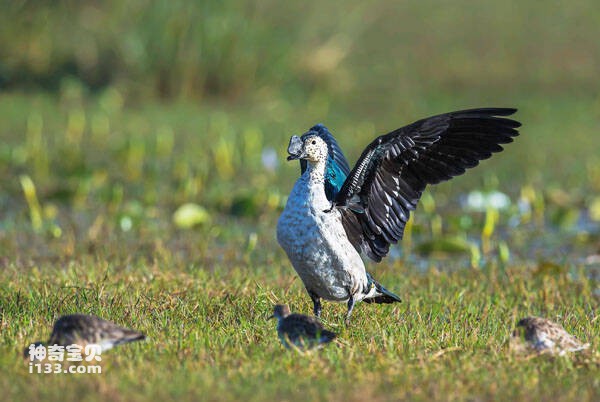Sarkidiornis melanotos
IUCN
LCBasic Information
Scientific classification
- name:Sarkidiornis melanotos
- Scientific Name:Sarkidiornis melanotos,Comb Duck
- Outline:Waterfowl
- Family:
Vital signs
- length:48-60CM
- Weight:1.2-2.6kg
- lifetime:No textual research information is available
Feature
The male duck has a large black sarcoplasma at the base of the upper bill
Distribution and Habitat
It is found in Angola, Argentina, Aruba, Bangladesh, Benin, Bolivia, Bonaire, Sant 'Eustatius and Saba, Botswana, Brazil, Burkina Faso, Burundi, Cambodia, Cameroon, Central African Republic, Chad, China, Colombia, Democratic Republic of the Congo, Cote d 'Ivoire, Curacao, Ecuador, Eritrea, Ethiopia, French Guiana, Gabon, Gambia, Ghana, Guinea, Guinea-Bissau, Guyana, India, Kenya, Lao People's Democratic Republic, Lesotho, Liberia, Madagascar, Malawi, Mali, Mauritania, Mozambique, Myanmar, Namibia, Nepal, Niger, Nigeria, Panama, Paraguay, Peru, Rwanda, Senegal , Sierra Leone, Saint Maarten (Netherlands), Somalia, South Africa, South Sudan, Sudan, Eswatini, United Republic of Tanzania, Thailand, Togo, Uganda, Uruguay, Venezuela, Bolivarian Republic, Viet Nam, Zambia, Zimbabwe.
Possible extinction: Pakistan, Sri Lanka. Travellers: Japan, Oman, SAO Tome and Principe, Trinidad and Tobago.
They inhabit thinly wooded open forests and forests near lakes, rivers, ponds and
Appearance
The male duck has an enlarged sarcoplasma at the base of the upper bill, white head and neck, with black spots with purple metallic luster, especially from the top of the head to the neck more dense, forming a black and shiny purple metallic luster of the longitudinal band. The upper body, except the lower back gray and near the tail of the upper cover feathers with black longitudinal lines, the rest and two wings are black, and blue-purple luster; The secondary feathers have a blue-green luster, the shoulder feathers have a slightly brown luster, the tail feathers are dark brown, and the upper tail feathers are dark brown with a slightly blue-green luster. The lower neck and lower body are white, the two flanks are white and tinged with light gray, and the chest feathers are grayish black, forming discontinuous scaly fine spots; There is a black collar on either side of the base of the lower neck. The tail is covered with white feathers, and there is a black horizontal band extending
Details
The Comb Duck (Sarkidiornis melanotos) has two subspecies.

The tumbler ducks feed mainly during the day. Foraging while swimming on grass or in shallow water near water. Food is mainly grass, grass leaves, rice, plant seeds and other plant foods, but also eat worms, aquatic insects, insect larvae and crustaceans, mollusks and small fish and other animal foods.

They nest in natural cavities in old trees close to the water or in the branches of large trees. They also nest in abandoned old nests of other large birds in trees, sometimes in the walls of isolated buildings, and in stone gaps and tall grass where there are no trees. The breeding season mainly varies with the rainy season, and in Southeast Asia, the breeding season is usually between June and September, and the strong and powerful males sometimes occupy more than two females. Each clutch lays 8-12 eggs, white or yellowish-white, with a size of 56-67 mm x 42-45 mm. The female incubates her eggs for 30 days.
Since 1914, when La Touche (1931-1934) obtained two male duck specimens in March and June respectively in Fuzhou, China, there have been no reports of any collection and sighting for decades. Surveys of Asian midwinter waterbirds conducted by the International Waterfowl Research Bureau in 1990 and 1992 showed only 1,500 individuals in South Asia and 56 in Southeast Asia. Apparently, the tumbler ducks only drifted to China by chance. Data on the size of the population outside Asia is lacking, but it is estimated that there are more than 70,000 named subspecies and about 80,000 South American subspecies.
Listed in the International Union for Conservation of Nature Red List of Threatened Species (IUCN) for 2016 ver 3.1 - Not Threatened (LC).
It was included in the List of Land Wild Animals under State Protection that are beneficial or have important economic and scientific research value (Item 66) issued by the State Forestry Administration of China on August 1, 2000.
Listed in Appendices I, II and III of the Convention on International Trade in Endangered Species of Wild Fauna and Flora (CITES) 2019 edition Appendix II.
Protect wild animals and eliminate wild meat.
Maintaining ecological balance is everyone's responsibility!








